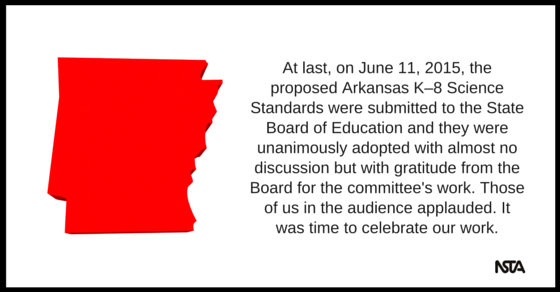How Arkansas Adopted the NGSS
By Guest Blogger
Posted on 2015-06-22
Last week Arkansas celebrated the adoption of the Next Generation Science Standards (NGSS) for K–8 students and work is ongoing for 9–12. We’ve had a strong connection with the NGSS since work began to develop them in 2011. Arkansas was designated as a Lead State along with 25 other states and we were fortunate to have two classroom teachers (Melissa Miller and Kathy Prophet) working as writers. I was fortunate to be selected as a Critical Stakeholder reviewer for the NGSS as they were being developed. In April 2014, the Arkansas State Board of Education voted unanimously to endorse the NGSS as the basis for the development of Arkansas’ new K–12 science standards. Based upon that action, the Arkansas Department of Education (ADE) under the leadership of Michele Snyder (ADE Science Specialist) assembled a team of over 40 stakeholders to begin the review and development of the K–8 Arkansas Science Standards. The committee included administrators, K–8 classroom teachers, university professors, science specialists, and other vital stakeholders. It was a diverse, committed, and talented group. ADE staff members in the assessment, curriculum, and technical departments were also present to assist the committee in its task.
The K–8 committee was divided into four teams and met on multiple occasions during the fall of 2014 and the spring of 2015. At the first meeting, the committee studied the basis for the NGSS, A Framework for K–12 Science Education (published by the National Research Council) and reviewed the NGSS, its three dimensions, and the appendices to build common understanding. At the second meeting, the committee began the difficult task of analyzing the student Performance Expectations in grades K–8. The committee chose to retain the existing NGSS K–2 standards untouched, and to add some Arkansas-specific clarification statements and assessment boundaries to the grades 3–5 PEs. Our greatest challenge came in assigning the grades 6–8 PEs to a specific grade level and writing a few Arkansas-specific clarification statements and assessment boundaries. We studied what previous NGSS-adopting states had done in assigning PEs and used that information to guide our work. Then using the committee’s work, the ADE produced three different models for the K–8 standards. The final meeting was laborious as the committee ultimately came to consensus on the Arkansas K–8 Science Standards by choosing the best pieces from all of the models and setting the format and numbering system for the Arkansas PEs based on the NGSS.
The ADA placed the Arkansas K–8 Science Standards online for a 30-day public comment period. Notifications were sent to schools and teachers state-wide so that interested parties could read the proposed standards and offer comments. We were pleased to see that over 80% of the comments received were supportive and favorable of the new standards! A small team of the K–8 committee met in early June to read and respond to all of the comments made during the public comment period and we made needed changes based on public comments. At last, on June 11, 2015, the proposed Arkansas K–8 Science Standards were submitted to the State Board of Education and they were unanimously adopted with almost no discussion but with gratitude from the Board for the committee’s work. Those of us in the audience applauded. It was time to celebrate our work.
We have now started work on the Arkansas 9–12 Science Standards. Our first meeting was in mid-June and I expect the development process to be similar to the work of the K–8 committee. I have enjoyed working with and learning from my colleagues while serving as an advisor for the committee. We hope to have a 9–12 standards proposal ready for public review and comments in early 2016 with submission to the State Board of Education for approval in the spring of 2016.
Arkansas has planned for a coordinated implementation of the new science standards. Professional development is required for teachers to become familiar with the conceptual shifts in science teaching that will need to be made to help students meet the expectations of the new Arkansas K–8 and 9–12 Science Standards. The grades K–4 standards will take effect in 2016–2017, and the grades 6–8 standards will be implemented in 2017–2018. When adopted, the 9–12 standards would take effect in 2018–2019.
To access resources and stay up-to-date on all developments regarding the adoption and implementation of the NGSS, in Arkansas and elsewhere in the United States, please bookmark the NGSS@NSTA hub. There, science teachers have access to general NGSS information, the standards by topic, curriculum planning guidance, vetted classroom resources, professional learning opportunities, and NGSS news.
 Steve Long teaches Pre-AP Chemistry, and ChemCom at Rogers High School (RHS) in Rogers, Arkansas, where he has worked for the past 25 years. Long is serving as an advisor to the Arkansas Department of Education assisting with developing the new Arkansas K-8 and 9-12 science standards.
Steve Long teaches Pre-AP Chemistry, and ChemCom at Rogers High School (RHS) in Rogers, Arkansas, where he has worked for the past 25 years. Long is serving as an advisor to the Arkansas Department of Education assisting with developing the new Arkansas K-8 and 9-12 science standards.
The mission of NSTA is to promote excellence and innovation in science teaching and learning for all.
Follow NSTA
Disclaimer: The views expressed in this blog post are those of the author(s) and do not necessarily reflect the official position of the National Science Teaching Association (NSTA).



